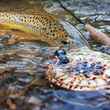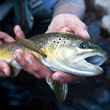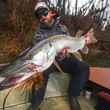Every angler of some experience is haunted by a mystery fish. Not simply “the one that got away”—the barefoot kid with the cane pole has been through that—but an encounter with the unknown, a temporary connection to an extraordinary force. Like a voice on the phone you can’t forget, or a stunning profile glimpsed in silhouette, it wants identity. Reeling in the lifeless, empty line, you tell yourself that you would have been satisfied just to see it, that a moment of recognition would have made all the difference. But where you desire closure and clarity there is only a raw and murky uncertainty. It lodges in your consciousness like a jagged foreign object, fraying the edges of your being.
My encounter happened in the kind of place you’d expect it to: Wisconsin’s Door Peninsula, the scarp of glaciated dolomite that extends, like the finger of a Dickensian ghost, into northern Lake Michigan. It’s big water prowled by big fish, and after more than a century of naïve but well-intentioned tinkering and ecological band-aids that became mass addictions it’s become a veritable bouillabaisse of native, exotic, and introduced species. Depending on seasonal migrations, water temperature (which can change dramatically in a matter of hours), availability of forage, and the inscrutable whims common to wild creatures of every stripe, you can literally catch anything. This is especially the case among the rock-bound bays and harbors, where you can find pelagic steelhead, brown trout, and even chinook salmon sharing the littoral zone with resident smallmouth bass and northern pike.
Somewhat curiously, fly fishing is seldom practiced here. There was a flurry of interest some time back in dredging for zeppelin browns from belly boats, lobbing alewife-imitating patterns on high-D sinking lines, but it petered out in a hurry; among other complications, getting to the fish typically required hiring a “mother ship” for delivery and retrieval, and being left to your own devices in a float tube in the middle of Lake Michigan tends to be a puckering experience.
The upshot is that when Andy Cook and I grab the eight-weights and launch his Lund, we have the water pretty much to ourselves. Smallmouth are our primary target but we welcome all comers. This is why we use the kind of overbuilt reels that, strictly in the context of smallmouth fishing, are like using chainsaws to cut butter. You simply never know.
The deep boulders showed jade-green, and I cast the weighted Woolly Bugger into the darker seam that marked the drop-off. I felt the briefest of tugs, nothing more than a peck, and Andy asked “Did something flash behind your fly?”
More Like This
“Yeah, I think so.”
I stripped a few more feet of line—and hung something heavy. Whatever it was—and it obviously wasn’t a bass—steamed for the middle of the bay, as purposeful and unhurried as the Queen Mary. I couldn’t turn it and there was no stopping it, so Andy fired up the motor and gave chase. By the time I’d recovered all the backing and some of the line the fish had sounded. Palming the reel, I exerted as much pressure as I dared. It was like trying to pry a manhole cover with a popsicle stick. Something had to give, and in this instance it was the tippet.
“Damn,” I sputtered, watching a flock of cormorants as they leapfrogged across the blue water, working over a school of alewives. “I just wish I’d seen that fish. What the hell do you think it was?”
“Your guess is as good as mine,” Andy shrugged. “A big pike, maybe? You know there are 25-pound northerns in here.”
“If it was a northern, it made the longest run of any nothern on record. You know, it kind of fought like a big lake trout. Weird for a laker to be this far inshore but stranger things have happened.”
And so it went for the rest of the day, the rest of the summer, and much of the following year. A lot of Leinenkugel’s was drunk in the pondering, which wasn’t all bad, although it failed to provide any real enlightenment. And as word of the mystery spread, angling friends weighed in with their own opinions. The consensus was that I’d tangled with a monster brown. Given the evidence, it seemed as logical a conclusion as any.
Then, in a single cosmic moment, the answer was revealed to us. It wasn’t a brown, or a laker, or a northern, or any of the usual suspects. It was the Golden Drum.
Which, because you’re undoubtedly wondering, is our chosen nickname for the common carp, a nickname inspired by its resemblance to the redfish, a.k.a. the “red drum.” Bull-shouldered physique, scales that suggest clanking medieval armor, underslung mouths, etc. (Someone dubbed the carp the “Golden Bone” but that’s always struck us as a little hoity-toity, also a bit of a reach.) By any name, this is a fish that, on the sparkling flats of northern Lake Michigan, averages ten-to-15 pounds (and routinely exceeds 20), pounces on a well-presented fly when it’s in the mood to, pulls extremely hard, and takes lots of string.
Indeed, a well-traveled angler of my acquaintance, a man who’s landed innumerable bonefish, many tarpon, and even a handful of permit, has in the course of a lifetime of angling been spooled exactly once—by a Lake Michigan carp. And the drag on one of Andy’s reels, a make with a sterling reputation among serious flats fishermen, uttered its death rattle in the midst of wrassling a 24-pounder. We know how much it weighed because, with the help of God and a tailwind, he was able to land it despite his drag being hors de combat.
One day when we were looking for smallies and not finding many, Andy spotted a pod of carp cruising past and idly lobbed a Clouser in their direction. He wasn’t expecting a response but damned if one of the fish didn’t dart ahead of the rest, gobble up his fly—and, after running deep into Andy’s backing with a kind of low-gear inexorability, give us a pretty good idea of the identity of my mystery fish.
We’ve been banging the golden drum for something like 20 years now, and while we like to think we’ve learned a thing or two, the bottom line is that sometimes they’re in the mood to eat and sometimes they’re not. You want to know something funny, though? Whenever I close my eyes and dream about that fish I never saw, summoning it from the depths of Lake Michigan to the bright surface of my imagination, it’s still a monster brown.




























Comments